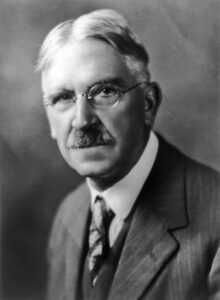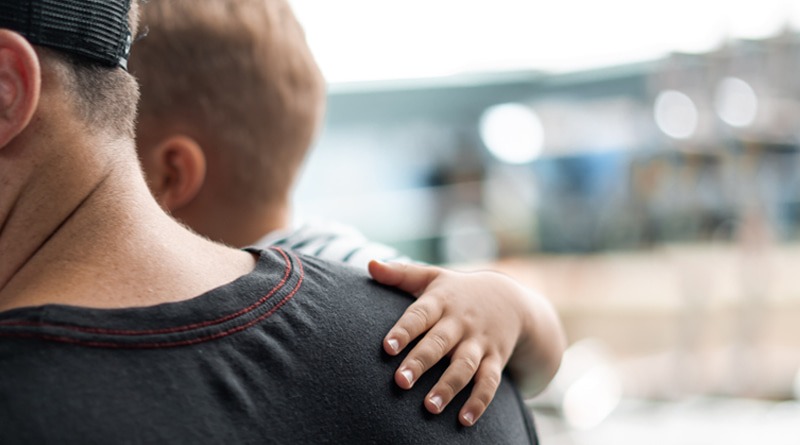
Dewey or Hooey?: Exploring the Concepts Behind the Dewey Classroom
By Joseph S. Lento, aka “The Maestro”
Dewey, Dewey, or Dewey?
Hello and welcome to another musing with The Maestro! Let’s hope we learn something about neurodiversity while having a little fun in the process. Today we will explore Dewey. No not Melvil Dewey who in 1876 invented the Dewey Decimal System used to classify the contents in a library. Many of us still remember being taught to open those long, thin beautiful wooden drawers filled with index cards, with numbers representing categories, topics, and subcategories.
If not Melvil Dewey, perhaps we will be talking about the former and widely popular mustachioed governor of New York, Thomas E. Dewey who famously mailed-in the Presidential Election of 1948 and subsequently lost to ‘Give em’ Hell’ Harry Truman. Nope! Not him either! So which Dewey are we going to discuss? Well, given our enthusiasm and passion for education, it must be the great psychologist and educational reformer John Dewey.
As we know, John Dewey was responsible for (not solely nor in isolation of others before or after him) the idea of considering all the various aspects of a child as a human being or the oft used term, the “whole child” in their learning process. How about that as a novel foundation for teaching?! Or do you believe that children ought to sit still (sometimes they need to) and be quiet (sometimes they need to) and ‘lovingly’ memorize every word that comes out of our mouths?
I do understand and appreciate Memorization, Rote, and Repetition — especially when teaching Instrumental Music, since repetition-based muscle-memory is intricately involved. To be clear, critical thinking as a stand-alone practice is not possible, but it should be at the forefront of all pedagogical practices. I do, however, respectfully suggest a well-balanced approach to anything we do in our classes is the best approach.
Now, getting back to John Dewey, many do not think much of his pedagogical practices. As a matter of fact, they think it’s just plain ol’ Hooey!! Before we skim the surface of John Dewey’s work (which is too complex for a complete analysis here; besides this is just to whet your appetite) let’s offer a brief background of Dr. Dewey.
The Man, and What He Left Behind

John Dewey
John Dewey was a Vermonter (I’m not sure if he was a Woodchuck or Flatlander) born in 1859 and died in 1952. John Dewey was a graduate of the Johns Hopkins University School of Psychology. Dewey’s philosophical, ideological, psychological and educational tenets were equally (as equal as equal might be) associated with:
Pragmatism – a philosophical tradition in which language and thought are seen as tools/mechanisms to predict outcomes. To solve problems and plans of action instead of merely describing things such as social constructs.
Pragmatists believe that knowledge, language, concepts, meaning, belief, and science—are all best viewed in terms of their practical uses and successes.
“Pragmatism began in the United States in the 1870s. Its origins are often attributed to the Philosophers Charles Sanders Peirce, William James, and John Dewey. In 1878, Peirce described it in his pragmatic maxim: “Consider the practical effects of the objects of your conception. Then, your conception of those effects is the whole of your conception of the object.” – American Psychological Association
Here are several other categories associated with the ‘Dewey Classroom’ and I offer them for your consideration. The following was extracted and gently edited from Britannica.
- Epistemology (justification): a Coherentist theory of justification that rejects the claim that all knowledge and justified belief rest ultimately on a foundation of no inferential knowledge or justified belief. A Coherentist states that justification is solely a function of a relationship between beliefs, none of which are privileged beliefs in the way maintained by foundationalist theories of justification.
- Epistemology (truth): a deflationary or pragmatic theory of truth; the former is the epistemological claim that assertions that predicate truth of a statement do not attribute a property called truth to such a statement while the latter is the epistemological claim that assertions that predicate truth of a statement attribute the property of useful-to-believe to such a statement.
- Metaphysics: a pluralist view that there is more than one sound way to conceptualize the world and its content.
- Philosophy of Science is an instrumentalist and scientific anti-realist view that a scientific concept or theory should be evaluated by how effectively it explains and predicts phenomena, as opposed to how accurately it describes objective reality.
- Philosophy of Language is an anti-representationalism view that rejects analyzing the semantic meaning of propositions, mental states, and statements in terms of a correspondence or representational relationship and instead analyzes semantic meaning in terms of notions like dispositions to action, inferential relationships, and/or functional roles (Behaviorism and Inference) not to be confused with Pragmatics, a sub-field of Linguistics with no relation to philosophical pragmatism.
- Additionally, forms of Empiricism, Fallibilism, Verification, and a Quinean Naturalist Meta Philosophy are all commonly used Elements of Pragmatist Philosophies. Many Pragmatists are Epistemological Relativists and see this to be an important facet of their pragmatism (e.g. Joseph Margolis), but this is controversial and other Pragmatists argue such Relativism to be seriously misguided (e.g. Hilary Putnam, Susan Haack).
Anti-Reification of Concepts and Theories
Dewey in The Quest for Certainty criticized what he called “the philosophical fallacy”: Philosophers often take categories (such as the mental and the physical) for granted because they don’t realize that these are nominal concepts that were invented to help solve specific problems.
This causes metaphysical and conceptual confusion. Various examples are the “ultimate Being” of Hegelian philosophers, the belief in a “realm of value“, the idea that logic, because it is an abstraction from concrete thought, has nothing to do with the action of concrete thinking.
David L. Hildebrand summarized the problem: “Perceptual inattention to the specific functions comprising inquiry led realists and idealists alike to formulate accounts of knowledge that project the products of extensive abstraction back onto experience.”
The prevailing theme of Dewey’s works was his steadfast belief in Democracy, (not to be confused with a Political Party) be it in Politics, Education, Communication or Journalism.
In 1888 Dewey stated: “Democracy and the one, ultimate, ethical ideal of humanity are to my mind synonymous.”
These thoughts centered around Two Fundamental Elements: Schools and a Civil Society with each requiring Reconstruction to foster an Education System rooted in experiences and interactions people have in their lives. “He asserted that complete democracy was to be obtained not just by extending voting rights but also by ensuring that there exists a fully formed public opinion, accomplished by communication among citizens, experts and politicians.” Stanford University Journal
That is a concise overview and below are some highlights of what a Dewey Classroom might look like in practice:
- Project Based Learning
- Collaboration
- Experiential Learning
- Interdisciplinary Projects
- Fieldwork of Theoretical Concepts in Application
- Reflective Practices
Leading a ‘Dewey Classroom’ takes great discipline and expert knowledge of the subject matter at hand. It requires leading without dragging. It requires expert modeling. It requires Contoured Pedagogical Language or more simply put, less blabbing and when you blab, make it concise and understandable.
It also requires the use of numerous resources other than a textbook. As a matter of my fact, I think that not using a textbook at all is even better. After all, the textbook can be heavier than a cement anchor at sea!
Putting it all into Practice
Enough of me babbling on, let’s do what Dewey would do and open this analysis to other voices. To help accomplish this I’ve asked two of the Resident Developmental Psychology Educators at Maria Regina High School to give us their thoughts on John Dewey and how it does or does not work with Neurodiversity. Here is Assistant Principal of Counseling and Student Life at Maria Regina High School in Hartsdale NY, Jennifer Dukarm.
“The greatest teacher, at any age, is experience. In the classroom, when the content becomes meaningful, real-life experience, the students become actively engaged in the learning process, solving problems, thinking critically and provoking emotions. The students have an opportunity to reflect on the process of learning. This, in turn, gives the teachers the opportunity to learn about what motivates and appeals to their students. It is a progressive and collaborative approach to learning that livens the classroom and engages students of all learning styles.” Jennifer Dukarm
Next is a quote from the Principal of Maria Regina High School, Mrs. Maria Carozza- McCaffrey
“As educators, we have an even greater responsibility than helping students to attain knowledge and accumulate information. We are privileged to prepare the next generation of our society – future doctors, lawyers, clerks, civil servants, mothers, fathers, friends – to face challenges and embrace opportunity. By encouraging exploration, questioning and collaboration in the classroom, we are preparing our students to be successful in their careers, in their personal relationships and as productive members of the community they choose to be a part of. In an ever-changing, rapidly evolving world, John Dewey’s theory of learning is more applicable than ever as it also indirectly fosters resilience – an area often overlooked as part of the responsibility of an educator. When students are given the space to explore and learn creatively, they are building confidence in their own ability to learn and succeed. Thus, when they are inevitably faced with challenges in life, they will be able to draw from a veritable toolbox of adaptable, solution-focused skills AND have the confidence that these skills will help them through any challenge. The same sense of responsibility that drives us as educators is the same sense of responsibility that is fostered in the experiential learning, adaptability and character development embodied by John Dewey’s theory of learning.” Maria Carrozza-McCaffrey
Both Principal Carrozza-McCaffrey and Assistant Principal Dukarm’s input speaks to the value of a Dewey Classroom. Both women are themselves models of those practices, and I thank them very much for their expert opinions.
If you are planning to begin a Dewey Classroom Model or want to see if your present practices are aligned with the Dewey Model, please consider the following:
Components of a Dewey Classroom
- Have various modalities of the information related to the topic at hand.
- Be certain of the information you intend to teach.
- Know the learning styles of your students.
- Don’t follow the script to a fault.
- Allow for a natural evolution of the topic
- Use what I refer to as ‘Take Off and Landing Points’ These are points at which you or the students act as the pilot and ‘take off’ on a point in the lesson in which you didn’t plan for but has a life of its own and is worth pursuing as related to the lesson. Conversely, when you hit ‘turbulence’ (the lesson is not going smoothly) use a Landing Point; refuel and take off again.
- Allow students to develop lessons, quizzes, tests etc. By doing that you are sneakily having them study and reinforce the information.
- Be involved in the small groups that naturally form in a classroom, and it’s so easy. Don’t stand at the front of the room and lecture. Walk around the room while you’re speaking. Pull up a chair and sit with a group and speak to everyone from the physical vantage point of the students.
- Be approachable and accessible.
- HAVE FUN!!!
We hope that you’ve found this brief and concise analysis of the Dewy Classroom informative and helpful in the incorporation of neurodiversity into your pedagogical mindset and best practices!

Joseph S. Lento, is a licensed Teacher of Orchestral Music and School District Administration. In 2014, President Obama named him a National Teacher of Arts and Humanities. Joseph also has commendations from Presidents George H.W. Bush, James Earl Carter and George W. Bush. In 1999, he was named NYC Public Schools Bronx County High Schools Teacher of the Year. Learn more at his website, Brasscomets.angelfire.com.




